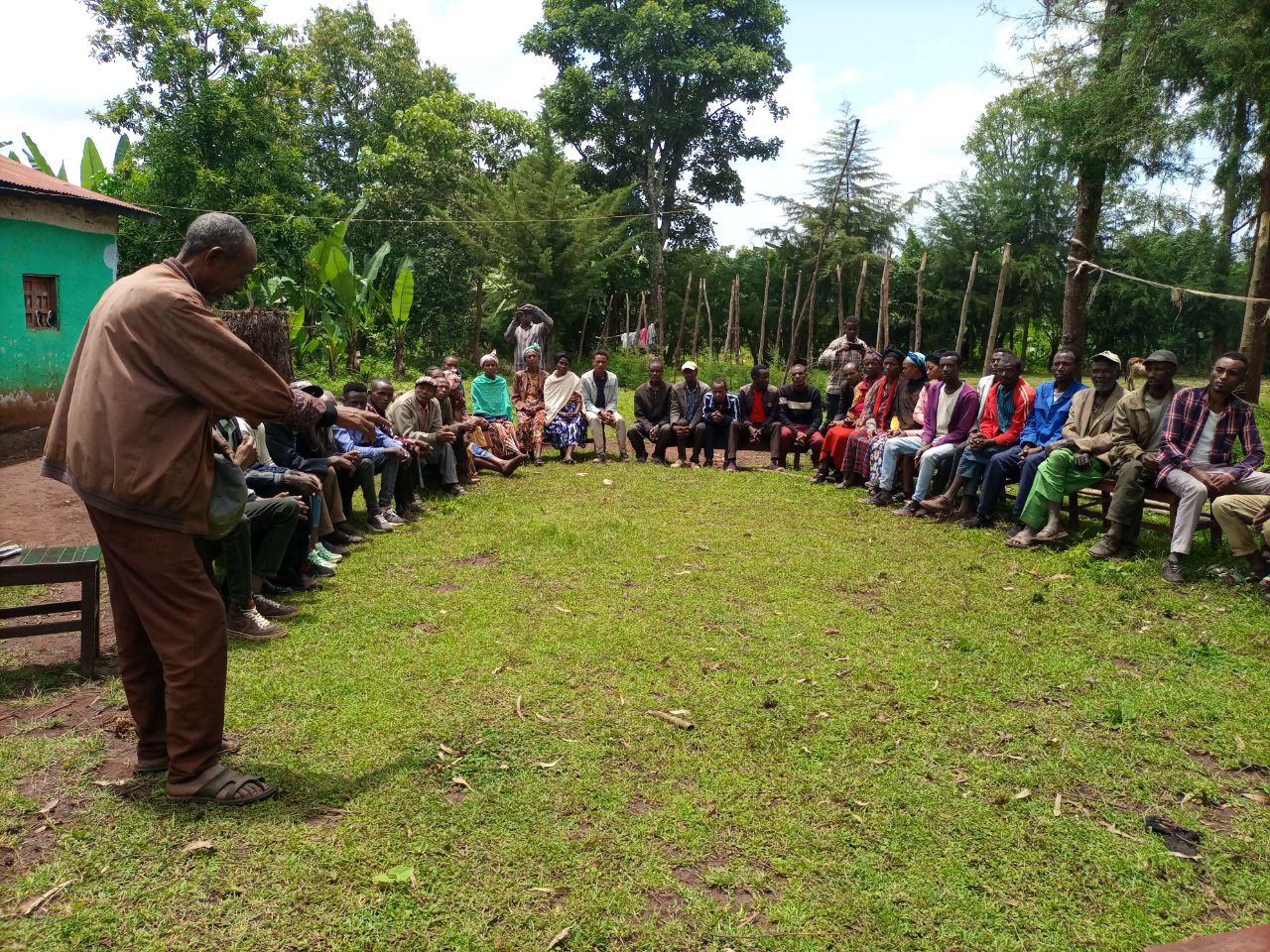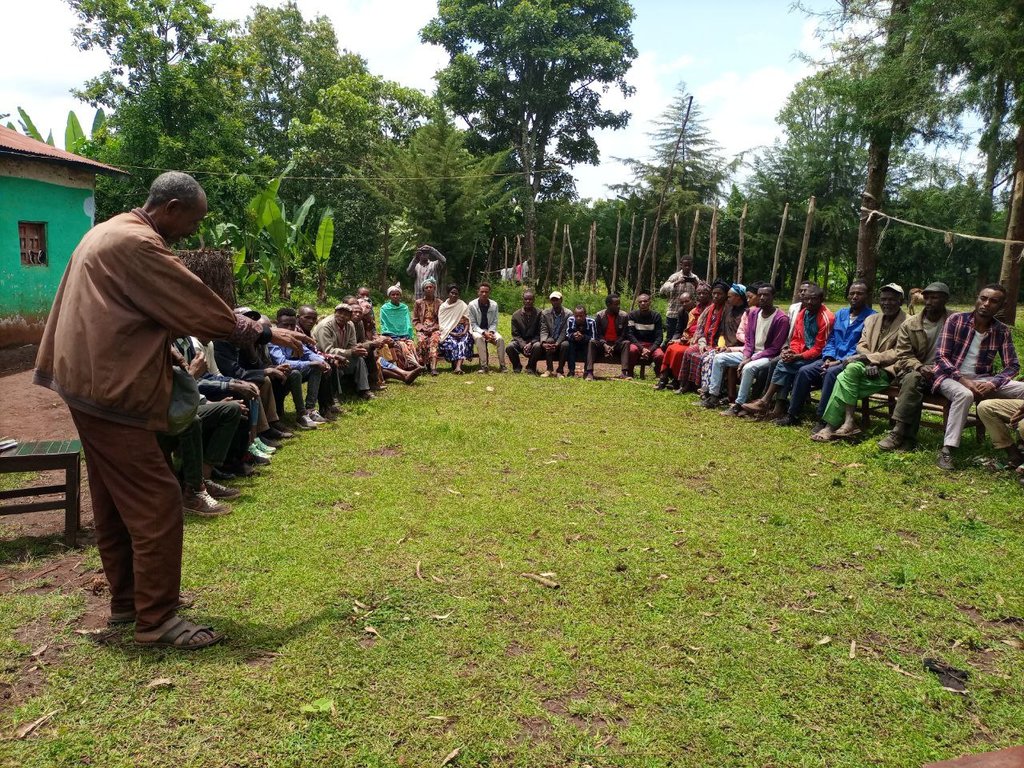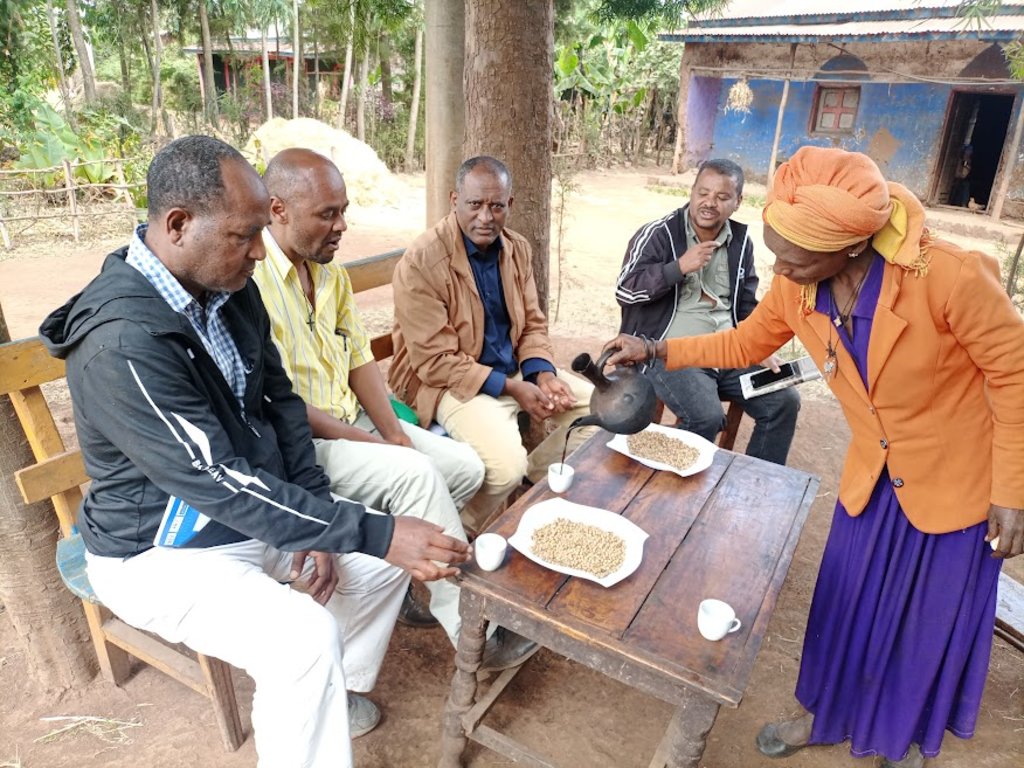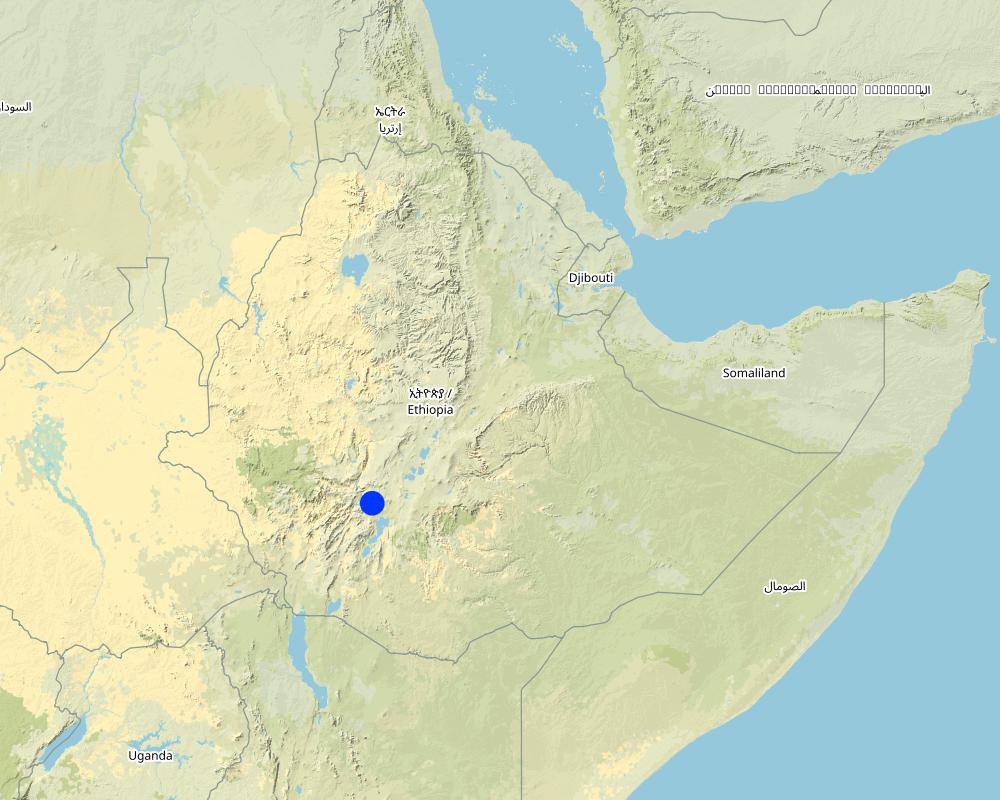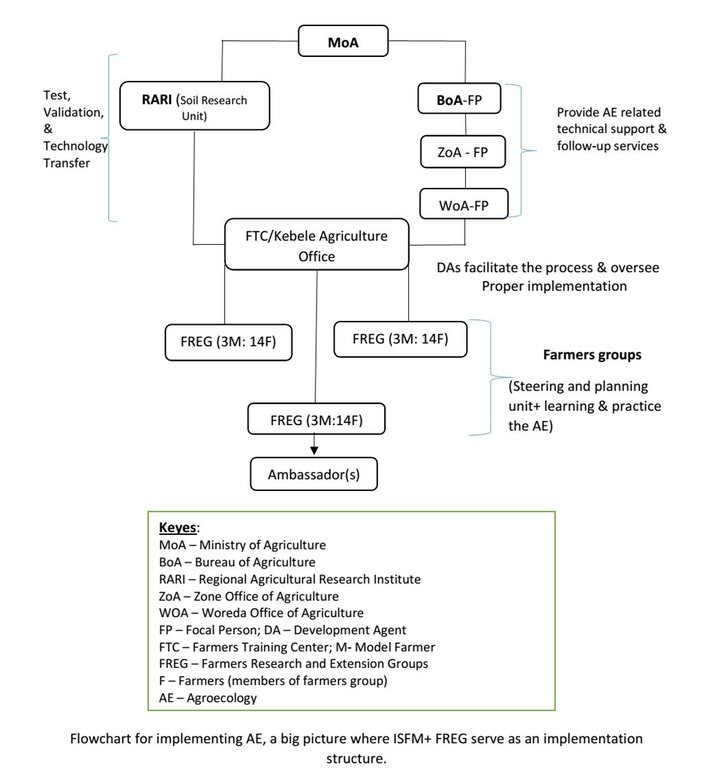Farmers Research and Extension Group (FREG) [Ethiopie]
- Création :
- Mise à jour :
- Compilateur : GERBA LETA
- Rédacteurs : Julia Doldt, Kidist Yilma, Noel Templer
- Examinateurs : William Critchley, Rima Mekdaschi Studer
FREG
approaches_6629 - Ethiopie
Voir les sections
Développer tout Réduire tout1. Informations générales
1.2 Coordonnées des personnes-ressources et des institutions impliquées dans l'évaluation et la documentation de l'Approche
Personne(s) ressource(s) clé(s)
Spécialiste GDT:
Feleke Temaledegn
+251967693410
temaledgn12@gmail.com
SNNPR Bureau of Agriculture
Hawassa
Ethiopie
Nom du projet qui a facilité la documentation/ l'évaluation de l'Approche (si pertinent)
Soil protection and rehabilitation for food security (ProSo(i)l)Nom du ou des institutions qui ont facilité la documentation/ l'évaluation de l'Approche (si pertinent)
Alliance Bioversity and International Center for Tropical Agriculture (Alliance Bioversity-CIAT) - Kenya1.3 Conditions relatives à l'utilisation par WOCAT des données documentées
Quand les données ont-elles été compilées (sur le terrain)?
16/01/2023
Le compilateur et la(les) personne(s) ressource(s) acceptent les conditions relatives à l'utilisation par WOCAT des données documentées:
Oui
1.4 Références au(x) questionnaire(s) sur les Technologies de GDT
2. Description de l'Approche de GDT
2.1 Courte description de l'Approche
A Farmers Research and Extension Group (FREG) engages about 50 or more farmers in a kebele (lower administrative unit), with three sub groups of 17-20 each who live in a homogenous landscape. It is a local institution established for joint learning, piloting, and evaluating soil improvement technologies across the intervention regions.
2.2 Description détaillée de l'Approche
Description détaillée de l'Approche:
Farmers Research and Extension Groups (FREGs) are the approach used to test and spread Integrated Soil and Fertility Management (ISFM+)/Agroecology project best practices in Ethiopia. These technologies include livestock urine collection and use, cover crops, intercropping, vermicompost, acid soil treatment by liming, green manures, crop residue management, and bioslurry. A FREG employs a participatory approach, whereby joint investigation and learning is implemented. Farmers' group members use participatory planning and peer learning from one another. The approach is gender inclusive: one-third of the members in a FREG are women. There is also a mix of social categories. FREGs are populated by proactive model farmers who adopt and demonstrate technologies for scaling up. After the first year, the best-performing model farmer serves as an ambassador for knowledge and skills transfer to the indirect beneficiaries.
Collective investigation, learning, adoption, and then promotion of proven technologies are the key features of the approach. Member of the FREG jointly identify soil fertility/acidity-related issues, participate in training and demonstrate the technologies. The ISFM+/ Agroecology projects equip the target groups with implementation skills and knowledge. Site and participant selection are made with participation of woreda and kebele representative partners and the target farmers. Then soil-related issues are jointly identified with the support of laboratory analysis by the Regional Research Institute. This demonstrates that the intervention is implemented by the public research and development actors with technical, financial and/or inputs supply from the projects. The approach tends to mobilize the communities living in similar agroecology and farming systems who are subjected to the same SLM-related issues.
Identifying proactive model farmers and establishing demonstration plots for different technologies and crop types are the basis of collective learning. The demonstration is employed as an experimental and learning plot by showcasing and inspiring farmer groups and indirect beneficiaries in the area. Organizing field days and exchange visits further enables the demonstration of technologies for scaling out. Experience shows that where ISFM+ technologies have been piloted, farmers have built up new agroecology technologies such as cover cropping, intercropping and woodlots development over and above those previously adopted. Target farmers have piloted at least three or more technologies/practices on their plots. The woreda office of agriculture through the assigned project focal person gives closer follow-up for the proper implementation of the technologies. Provision of technical support and advisory service via the development agents (DAs) are among many other services.
2.3 Photos de l'approche
2.4 Vidéos de l'Approche
Commentaire, brève description:
Videos of the approach is not documented.
2.5 Pays/ région/ lieux où l'Approche a été appliquée
Pays:
Ethiopie
Région/ Etat/ Province:
Southern Nations, Nationalities and People Region (SNNPR)
Autres spécifications du lieu :
Sodo Zuria district, Kuto-Sarfela kebele
Map
×2.6 Dates de début et de fin de l'Approche
Indiquez l'année de démarrage:
2022
Commentaires:
The project is expected to go up to the end of 2025.
2.7 Type d'Approche
- fondé sur un projet/ programme
2.8 Principaux objectifs de l'Approche
To promote participatory implementation and peer-to-peer learning by increasing its scope from plot based to landscape scale. The approach capacitates the farmers' group and stimulates the scaling of the approach at a larger scale.
2.9 Conditions favorisant ou entravant la mise en œuvre de la(des) Technologie(s) appliquée(s) sous l'Approche
normes et valeurs sociales/ culturelles/ religieuses
- favorise
Increasing soil degradation, growing infrequent moisture stress, and farmers' willingness to manage their land can be considered enabling factors.
- entrave
Giving priority to food crops due to shortage of farmland, climbing traits of the companion/cover crop that may cause harvesting inconvenience if not managed very well.
cadre institutionnel
- favorise
The establishment of FREG at local level promotes the implementation of the technology. The involvement of public research and development actors support to implement evidence based and problem solving practices.
collaboration/ coordination des acteurs
- favorise
Woreda focal person, development agents, and farmers' group are supporting participatory planning, implementation, and evaluation. The involvement of different actors promotes collaboration and collective action.
cadre juridique (régime foncier, droits d'utilisation des terres et de l'eau)
- favorise
The availability of a legal framework builds farmers' confidence to invest in their land.
cadre politique
- favorise
Support the SLM initiative via the green legacy.
connaissances sur la GDT, accès aux supports techniques
- favorise
It facilitates effective implementation of technologies/approaches.
charge de travail, disponibilité de la main-d'œuvre
- entrave
Shortage of labor and costs are hindering appropriate implementation.
3. Participation et rôles des parties prenantes impliquées dans l'Approche
3.1 Parties prenantes impliquées dans l'Approche et rôles
- exploitants locaux des terres / communautés locales
Members of farmers group
Participate in participatory planning, implementation, and evaluation of the intervention.
- Spécialistes de la GDT/ conseillers agricoles
Woreda Natural Resource Management experts or project focal person and development agents.
Facilitate farmers' group meetings during participatory planning, implementation, and participatory evaluation of the activities. Also, provide technical support to the implementers at the various stages of project implementation.
- gouvernement local
Kebele administration
Assist in technology scaling up/out via mobilizing the community to learn and adopt from the pilot activities.
- gouvernement national (planificateurs, décideurs)
Ministry of Agriculture
Establish an agreement with the project and support it in steering the institutionalization of proven technologies for scaling out via policy support.
- organisation internationale
GIZ
Provide financial, technical and material support to the partner organizations and the end users of the project intervention via the public line offices.
3.2 Participation des exploitants locaux des terres/ communautés locales aux différentes phases de l'Approche
| Participation des exploitants locaux des terres/ communautés locales | Spécifiez qui était impliqué et décrivez les activités | |
|---|---|---|
| initiation/ motivation | interactive | Farmers' group involved in participatory planning, experience exchange visit, and evaluation of the activities. Agricultural experts, development agents, and project staff oversee the implementation of activities and provide technical support/advisory services. |
| planification | interactive | Target farmers and development agents involved in problem identification/assessment and planning. |
| mise en œuvre | interactive | Farmers who are members of the FREG are involved in implementing the technology with technical support from the woreda focal person and the DAs. |
| suivi/ évaluation | interactive |
3.3 Diagramme/ organigramme (si disponible)
Description:
Agroecology/ISFM+ implementation flow chart that ran from the Ministry of Agriculture to the local level institution, the FREG. The role of stakeholders at different levels are briefly described in the flow chart.
Auteur:
Gerba Leta
3.4 Prises de décision pour la sélection de la Technologie/ des Technologies
Indiquez qui a décidé de la sélection de la Technologie/ des Technologies à mettre en œuvre:
- tous les acteurs concernés dans le cadre d'une approche participative
Expliquez:
Land users, SLM experts, Development Agents (DAs), and project advisors play a substantial role in participatory decision-making on the selection of SLM Technologies.
Spécifiez sur quelle base ont été prises les décisions:
- l'évaluation de connaissances bien documentées en matière de GDT (prises de décision fondées sur des preuves tangibles)?
- les résultats de recherches?
4. Soutien technique, renforcement des capacités et gestion des connaissances
4.1 Renforcement des capacités/ formation
Une formation a-t-elle été dispensée aux exploitants des terres/ autres parties prenantes?
Oui
Spécifiez qui a été formé:
- exploitants des terres
- personnels/ conseillers de terrain
Si pertinent, spécifiez le genre, l'âge, le statut, l'ethnie, etc.
Women-headed households are a member of the three model farmers in the sub-group of FREG. In general, the approach involves women one-third of the group members.
Formats de la formation:
- sur le tas
- entre agriculteurs (d'exploitants à exploitants)
- zones de démonstration
- réunions publiques
Thèmes abordés:
The concepts of agroecology, integrated soil fertility management and overall benefits of cover cropping and related crops such as Desmodium.
Commentaires:
The approach stimulates to conduct farmers group meeting at the beginning of the season as well as for end season evaluation of the pilot technologies.
4.2 Service de conseils
Les exploitants des terres ont-ils accès à un service de conseils?
Oui
Spécifiez si le service de conseils est fourni:
- dans les champs des exploitants?
- dans des centres permanents
Décrivez/ commentez:
The advisory service is face-to-face on demonstration plots at various crop stages including for split application of Urea fertilizer, disease/pest management time, harvesting, and post-harvesting.
4.3 Renforcement des institutions (développement organisationnel)
Des institutions ont elles été mises en place ou renforcées par le biais de l'Approche?
- oui, modérément
Spécifiez à quel(s) niveau(x), ces institutions ont été renforcées ou mises en place:
- local
Décrivez l'institution, ses rôles et responsabilités, ses membres, etc.
FREG has three model farmers leading the group. They mobilize their followers, demonstrate technologies, and steer collective action. Farmers' groups along with agricultural experts and project staff support the selection of technologies and replacement of the existing ones if the need emerges.
- Facilitation/mobilization
4.4 Suivi et évaluation
Le suivi et l'évaluation font ils partie de l'Approche? :
Oui
Commentaires:
Participatory monitoring and evaluation are part of the FREG approach. Essentially, beginning and end-season evaluation is the approach employed in the implementation of new technologies.
Si oui, ce document est-il destiné à être utilisé pour le suivi et l'évaluation?
Oui
4.5 Recherche
La recherche a-t-elle fait partie intégrante de l’Approche?
Oui
Spécifiez les thèmes:
- technologie
Donnez plus de détails et indiquez qui a mené ces recherches:
Research is part of the introduced technologies. Problem identification is the entryway to introducing a new technology/practice. Regional Agricultural Research Institute involves in the assessment and identification of problems, evaluation, and issuance of appropriate recommendations that make the intervention evidence-based.
5. Financement et soutien matériel externe
5.1 Budget annuel de la composante GDT de l'Approche
Si le budget annuel précis n'est pas connu, indiquez une fourchette:
- 2 000-10 000
Commentez (par ex. principales sources de financement/ principaux bailleurs de fonds):
The budget is generally allocated to support woreda's operational cost and to supply necessary inputs for the implementation of ISFM+ and the Agroecology projects.
5.2 Soutiens financiers/ matériels fournis aux exploitants des terres
Les exploitants des terres ont-ils reçu un soutien financier/ matériel pour la mise en œuvre de la Technologie/ des Technologies?
Non
5.3 Subventions pour des intrants spécifiques (incluant la main d'œuvre)
- aucun
5.4 Crédits
Des crédits ont-ils été alloués à travers l'Approche pour les activités de GDT?
Non
5.5 Autres incitations ou instruments
D'autres incitations ou instruments ont-ils été utilisés pour promouvoir la mise en œuvre des Technologies de GDT?
Oui
Si oui, spécifiez:
For best-performing farmers, incentives such as solar panels, energy-saving cooking stoves, wheelbarrows, etc., are offered to further motivate the farmers and enable them to properly implement the technology and become a very good advocator for scaling the beneficial practices.
6. Analyses d'impact et conclusions
6.1 Impacts de l'Approche
Est-ce que l'Approche a autonomisé les exploitants locaux des terres, amélioré la participation des parties prenantes?
- Non
- Oui, un peu
- Oui, modérément
- Oui, beaucoup
Land users are decision makers on selection of technologies.
Est-ce que l'Approche a permis la prise de décisions fondées sur des données probantes?
- Non
- Oui, un peu
- Oui, modérément
- Oui, beaucoup
Through piloting and learning from the technologies.
Est-ce que l'Approche a aidé les exploitants des terres à mettre en œuvre et entretenir les Technologies de GDT?
- Non
- Oui, un peu
- Oui, modérément
- Oui, beaucoup
Est-ce que l'Approche a amélioré la coordination et la mise en œuvre de la GDT selon un bon rapport coût-efficacité?
- Non
- Oui, un peu
- Oui, modérément
- Oui, beaucoup
Est-ce que l'Approche a mobilisé/ amélioré l'accès aux ressources financières pour la mise en œuvre de la GDT?
- Non
- Oui, un peu
- Oui, modérément
- Oui, beaucoup
Est-ce que l'Approche a amélioré les connaissances et les capacités des exploitants des terres pour mettre en œuvre la GDT?
- Non
- Oui, un peu
- Oui, modérément
- Oui, beaucoup
Est-ce que l'Approche a amélioré les connaissances et les capacités des autres parties prenantes?
- Non
- Oui, un peu
- Oui, modérément
- Oui, beaucoup
Est-ce que l'Approche a construit/ renforcé les institutions, la collaboration entre parties prenantes?
- Non
- Oui, un peu
- Oui, modérément
- Oui, beaucoup
Est-ce que l'Approche a atténué les conflits?
- Non
- Oui, un peu
- Oui, modérément
- Oui, beaucoup
Est-ce que l'Approche a autonomisé les groupes socialement et économiquement défavorisés?
- Non
- Oui, un peu
- Oui, modérément
- Oui, beaucoup
Est-ce que l'Approche a amélioré l'égalité entre hommes et femmes et autonomisé les femmes et les filles?
- Non
- Oui, un peu
- Oui, modérément
- Oui, beaucoup
Est-ce que l'Approche a encouragé les jeunes/ la prochaine génération d'exploitants des terres à s'engager dans la GDT?
- Non
- Oui, un peu
- Oui, modérément
- Oui, beaucoup
Est-ce que l'Approche a amélioré les questions foncières et des droits d'utilisation qui entravent la mise en œuvre des Technologies?
- Non
- Oui, un peu
- Oui, modérément
- Oui, beaucoup
Est-ce que l'Approche a conduit à améliorer la sécurité alimentaire et/ou la nutrition?
- Non
- Oui, un peu
- Oui, modérément
- Oui, beaucoup
Est-ce que l'Approche a amélioré l'accès aux marchés?
- Non
- Oui, un peu
- Oui, modérément
- Oui, beaucoup
Est-ce que l'Approche a conduit à améliorer l'accès à l'eau et l'assainissement?
- Non
- Oui, un peu
- Oui, modérément
- Oui, beaucoup
Est-ce que l'Approche a conduit à l'utilisation/ sources d'énergie plus durables?
- Non
- Oui, un peu
- Oui, modérément
- Oui, beaucoup
Est-ce que l'Approche a amélioré la capacité des exploitants des terres à s'adapter aux changements/ extrêmes climatiques et a atténué les catastrophes liées au climat?
- Non
- Oui, un peu
- Oui, modérément
- Oui, beaucoup
Est-ce que l'Approche a conduit à des emplois, des opportunités de revenus?
- Non
- Oui, un peu
- Oui, modérément
- Oui, beaucoup
6.2 Principale motivation des exploitants des terres pour mettre en œuvre la GDT
- augmenter la production
The approach improves farmers' understanding of the benefits of improving soil fertility and soil health, and overall production, and productivity of the soil.
- augmenter la rentabilité/ bénéfice, rapport coûts-bénéfices
- réduire la dégradation des terres
- conscience environnementale
- améliorer les connaissances et compétences en GDT
6.3 Durabilité des activités de l'Approche
Les exploitants des terres peuvent-ils poursuivre ce qui a été mis en œuvre par le biais de l'Approche (sans soutien extérieur)?
- oui
Si oui, décrivez de quelle manière:
The positive outcome of applying the FREG is considered as a payoff for participating farmers as it gave them the energy to sustain the adopted practices. The outputs of integrating technologies, collective learning, and action allow to see significant yield increment per unit of land, improved soil fertility and soil health, etc.
6.4 Points forts/ avantages de l'Approche
| Points forts/ avantages/ possibilités du point de vue de l'exploitant des terres |
|---|
| Increases farmers understanding of SLM and enables to improve soil fertility and soil health. |
| Allows direct and indirect beneficiaries to adopt beneficial agricultural practices. |
| Promote peer learning to apply technologies that nurture soil fertility and increase crop production and productivity, supply feed to the livestock, manage pests... |
| Points forts/ avantages/ possibilités du point de vue du compilateur ou d'une autre personne ressource clé |
|---|
| Ensure stakeholders' participation and allows the development of a sense of ownership of the technology. |
| Promote knowledge sharing for scaling out of the technologies. |
6.5 Faiblesses/ inconvénients de l'Approche et moyens de les surmonter
| Faiblesses/ inconvénients/ risques du point de vue de l’exploitant des terres | Comment peuvent-ils être surmontés? |
|---|---|
| The farmers' group meeting is not so strong and there are absentees or dropouts because of the overlaps with other regular and casual meetings, and private chores. | Strengthening appropriate participation in planning, implementation, collective learning and action process. |
| Faiblesses/ inconvénients/ risques du point de vue du compilateur ou d'une autre personne ressource clé | Comment peuvent-ils être surmontés? |
|---|---|
| Lower level of farmers' commitment and non-zealous to bring change with positive impacts. | Need regular follow-up and continuous awareness creation exercises. |
| Take the project intervention for granted | Mainstreaming further land-related issues and the necessity of adopting ISFM and agroecology practices to ensure the sustainability of the management intervention. |
7. Références et liens
7.1 Méthodes/ sources d'information
- visites de terrain, enquêtes sur le terrain
Operational field visited.
- interviews/entretiens avec les exploitants des terres
Interview and discussion made with a land user.
- interviews/ entretiens avec les spécialistes/ experts de GDT
A regional expert, project focal person, and regional advisor were consulted.
7.2 Références des publications disponibles
Titre, auteur, année, ISBN:
Agricultural extension approach: evidence from an Integrated Soil Fertility Management project in Ethiopia. Leta, G., Schulz, S., Alemu, G. 2020. DOI: 10.15302/J-FASE-2020331
Disponible à partir d'où? Coût?
https://www.researchgate.net (Free online)
Titre, auteur, année, ISBN:
Evaluation of Farmer Research Extension Group as Extension Approach: The experience of Sida-Amhara Rural Development Program in Kalu District of Amhara Region, Ethiopia. Abebe, E. 2008.
Disponible à partir d'où? Coût?
https://depot.wur.nl/1129
7.3 Liens vers les informations pertinentes disponibles en ligne
Titre/ description:
Farmer research and extension
URL:
https://www.researchgate.net/publication/5055710_Farmer_research_and_extension
Titre/ description:
Basics of cover cropping
URL:
https://organicgrowersschool.org/gardeners/library/basics-of-cover-cropping/
Liens et modules
Développer tout Réduire toutLiens
Aucun lien
Modules
Aucun module trouvé


